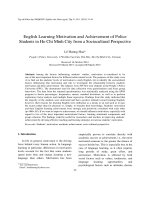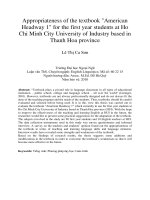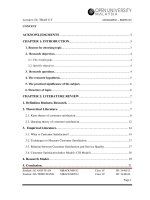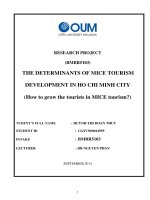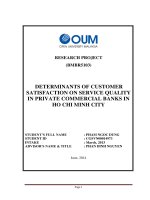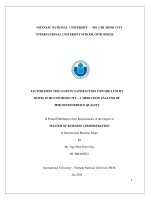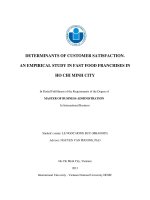Post choice satisfaction of vietnamese undergraduate students in ho chi minh city
Bạn đang xem bản rút gọn của tài liệu. Xem và tải ngay bản đầy đủ của tài liệu tại đây (2 MB, 135 trang )
POST-CHOICE SATISFACTION OF VIETNAMESE
UNDERGRADUATE STUDENTS
IN HO CHI MINH CITY
In partial Fulfillment of the Requirements of the Degree of
MASTER OF BUSINESS ADMINISTRATION
In Marketing
By
Ms. Ly Thi My Dung
ID: MBA03009
International University – Vietnam National University HCMC
February 2013
i
POST-CHOICE SATISFACTION OF VIETNAMESE UNDERGRADUATE
STUDENTS IN HO CHI MINH CITY
In Partial Fulfillment of the Requirements of the Degree of
MASTER OF BUSINESS ADMINISTRATION
In Marketing
by
Ms. Ly Thi My Dung
ID: MBA03009
International University - Vietnam National University HCMC
February 2013
Under the guidance and approval of the committee, and approved by all its members, this thesis
has been accepted in partial fulfillment of the requirements for the degree.
Approved:
Chairperson
----------------------------------------------
----------------------------------------------
Committee member
Committee member
----------------------------------------------
---------------------------------------------
Committee member
Committee member
----------------------------------------------
---------------------------------------------
i
Acknowledge
This thesis is my last and most important project in Marketing major of Master
program at International University, HCM City. The research could not be done without the
support of many individuals. I would like to take this opportunity to thank people who
helped me in different ways during my work.
Firstly, I respectfully thank my helpful instructor, Prof. Le Nguyen Hau, for his
extraordinary support. His unwavering support, invaluable mentorship, and insightful ideas
shaped both my thesis and my character. He has been expectations, fair with his constructive
criticism, and a great source of information. Secondly, I would like to thank to people who
spent time with me on survey and interviews for collecting information. Thirdly, I want to
thank my friends in MBA class who share me more useful information. Finally, I really
appreciate my professors and lecturers in MBA class who give me a lot of wonderful
knowledge in this course.
ii
Plagiarism Statements
I would like to declare that, apart from the acknowledged references, this thesis
either does not use language, ideas, or other original material from anyone; or has not been
previously submitted to any other educational and research programs or institutions. I fully
understand that any writings in this thesis contradicted to the above statement will
automatically lead to the rejection from the MBA program at the International University –
Vietnam National University Ho Chi Minh City.
iii
Copyright Statement
This copy of the thesis has been supplied on condition that anyone who consults it
is understood to recognize that its copyright rests with its author and that no quotation from
the thesis and no information derived from it may be published without the author‟s prior
consent.
© Ly Thi My Dung/ MBA03009/2011-2013
iv
Table of Contents
List of Tables ...................................................................................................................... viii
List of Figures ....................................................................................................................... ix
Abstract
............................................................................................................................x
CHAPTER ONE - INTRODUCTION....................................................................................1
I. BACKGROUND ...........................................................................................................1
II. RATIONALE OF THE STUDY ...................................................................................4
III. RESEARCH OBJECTIVE ............................................................................................5
IV. RESEARCH QUESTION .............................................................................................6
V. RESEARCH METHODOLOGY ..................................................................................6
VI. SCOPE...........................................................................................................................7
VII. SIGNIFICANCE OF THE RESEARCH ..................................................................7
VIII. PROPOSED STRUCTURE ......................................................................................7
CHAPTER TWO - LITERATURE REVIEW ........................................................................9
I. DEFINITION OF EDUCATION ..................................................................................9
II. DEFINITION OF STUDY ............................................................................................9
III. QUALITY IN EDUCATION ......................................................................................10
IV. STUDENT PERCEIVED VALUE .............................................................................10
V. CUSTOMER SATISFACTION ..................................................................................11
VI. THE EUROPEAN CUSTOMER SATISFACTION INDEX MODEL ......................11
1.
The evolution of national satisfaction index models ............................................11
2.
The European Customer Satisfaction Index model ..............................................12
CHAPTER THREE – CONCEPTUAL FRAMEWORK AND RESEARCH
HYPOTHESES ................................................................................................17
I. FACTORS INFLUENCING ON STUDENT SATISFACTION ................................17
1.
Image ....................................................................................................................17
2.
Perceived quality of teaching and learning ..........................................................18
3.
Perceived quality of student support services ......................................................18
4.
Perceived quality of facilities and resources ........................................................19
5.
Perceived value and sacrifice ...............................................................................19
v
II. CONCEPTUAL FRAMEWORK AND HYPOTHESES ...........................................21
CHAPTER FOUR – RESEARCH METHODOLOGY ........................................................23
I. RESEARCH DESIGN ................................................................................................23
II. RESEARCH APPROACH ..........................................................................................24
1.
Qualitative research ..............................................................................................25
2.
Quantitative research ............................................................................................25
3.
Construct measurement ........................................................................................25
III. QUESTIONNAIRE DESIGN .....................................................................................34
IV. PILOT STUDY ...........................................................................................................35
V. DATA COLLECTION METHOD ..............................................................................35
1.
Sample ..................................................................................................................35
2.
Sample size ...........................................................................................................36
3.
Sampling method ..................................................................................................37
VI. Data analysis techniques..............................................................................................37
1.
Data analysis techniques ......................................................................................37
2.
Coefficient alpha ..................................................................................................37
3.
Exploratory factor analysis (EFA) .......................................................................38
4.
Regression analysis ..............................................................................................38
5.
One-Way ANOVA ...............................................................................................38
CHAPTER FIVE – DATA ANALYSIS AND RESULTS...................................................40
I. SAMPLE DEMOGRAPHICS .....................................................................................40
II. DESCRIPTIVE STATISTICS OF FACTORS OF ECSI ...........................................42
1.
Independent variables ...........................................................................................43
2.
Dependent variables (Sample of 404 cases) .........................................................46
3.
Evaluation reliability of measurement (Cronbach‟s Alpha before EFA) .............46
4.
Evaluation of measurement‟s structure (Exploratory Factor Analysis - EFA) ....49
5.
Regression and hypotheses testing results of the relationship between
independent variables and dependent variable .....................................................56
6.
ANOVA Test ........................................................................................................60
vi
III. DISCUSSION AND IMPROVEMENT .....................................................................60
1.
Student satisfaction among group of student .......................................................60
2.
Discussion and suggestion for university managers.............................................61
CHAPTER SIX – CONCLUSION AND RECOMMENDATION ......................................68
I. CONCLUSION ...........................................................................................................68
II. LIMITATION AND RECOMMENDATION FOR FURTHER RESEARCH ..........70
REFERENCES .....................................................................................................................71
APPENDIX ..........................................................................................................................78
vii
List of Tables
Table 1. List of hypotheses ...............................................................................................21
Table 2. Construct measurement scales .............................................................................32
Table 3. The name of university ........................................................................................40
Table 4. Table of student‟s major ......................................................................................41
Table 5. Demographic characteristics ...............................................................................41
Table 6. Descriptive statistics of independent variables (sample of 404 cases) ................45
Table 7. Descriptive satisfices of dependent variables ......................................................46
Table 8. Cronbach‟s Alpha before EFA ............................................................................48
Table 9. EFA results for independent variables ................................................................52
Table 10. Re-coding for independent variables ................................................................53
Table 11. EFA results for dependent variables ..................................................................54
Table 12. EFA and Cronbach‟s Alpha after EFA of independent variables ......................55
Table 13. Correlations........................................................................................................57
Table 14. Results of the relationship between image, quality, value and satisfaction ......57
Table 15. Coefficients .......................................................................................................58
Table 16. Hypothesis results .............................................................................................59
Table 17. Differences among student groups to CS in each university ............................60
Table 18. Final factors influence on student satisfaction ..................................................69
viii
List of Figures
Figure 1. The original SCSB (Swedish Customer Satisfaction Barometer) model ...........13
Figure 2. The ACSI (American Customer Satisfaction Index) model ...............................14
Figure 3. The ECSI (European Customer Satisfaction Index) model ................................15
Figure 4. Proposed Research Model .................................................................................21
Figure 5. Research process ................................................................................................24
Figure 6. Revised Research model.....................................................................................60
ix
Abstract
Nowadays, it is necessary that service providers of school try to develop and offer
high quality as well as increase customer satisfaction by service experience. It requires a
deeply understanding of the factors, which lead to positive perceptions of schools‟ services.
In the current study, the main research subject is students, whose university experience is
found out because learning environment may enhance the students experience by
encouraging participation. Therefore, this study reviews existing literatures on students
satisfaction and measurement, specifically how it affects in education industry.
Until now, there are a lot of studies, which have been conducted about this topic
and various results have been found in many countries but just only few study about this
topic was conducted in Vietnam. That is why this study is done by surveying 404 freshman
students, who have studied at six universities in Ho Chi Minh City to examine the
relationship between students' overall satisfaction with influential factors, such as image,
quality and value.
The results of the analysis are based on insight into the satisfaction and service
quality constructs in HCMC in Vietnamese higher education sector. The research also
provides a conceptual framework for understanding the impact of the dimensions on
service quality and the impact of service quality on constructs, which include image, value
and satisfaction. Furthermore, this study will assist management of higher education to
develop and implement the service strategy in market orientation to achieve the higher
service quality as well as the higher education quality to enhance the students‟ satisfaction
level.
Keywords: The European American Customer Satisfaction Index (ECSI) Model,
Higher Education, Perceived Quality, Perceived Value, Students‟ Satisfaction, SPSS.
x
xi
CHAPTER ONE - INTRODUCTION
This chapter presented the rationale of the thesis and reason of conduct this
research. After the problem formulation, the objective of the thesis was stated, and then
followed by research question, delimitation and outline of the thesis.
I. BACKGROUND
Nowadays, most of university marketers all over the world are interested in
understanding and managing the students‟ experience. It has appeared and has been
controlled by many challenges, in which the high rate of withdrawal from schools was
represented for those challenges. Besides, students have viewed education as a
necessity to meet the industry needs as well as the global competitive environment.
Furthermore, it required marketers to deeply understand the university experience from
students‟ perspective to enhance the level of student satisfaction and loyalty (Mansfield
& Warwick, 2006). This issue particularly related to the first year students because this
was the year that students expected about their learning environment, the quality of
their education and value, which they would perceive from their qualification have
established. Therefore, these determinants of student experience became an important
subject for higher education institutions (HEIs) for managing purpose as well as
retaining students and attracting potential students (Helgesen, 2008).
As any organization, HEIs depended on offering high quality to create students‟
satisfaction of service experiences to keep competition in the educational field. Besides,
it included the development of higher education services to meet students‟ expectations
and provided students an enriching educational experience. The developmental
1
experience could obtain both of inside and outside the classroom, as well as between
service providers and students, and between groups of the students themselves. Thus,
students were viewed as the center subject that a school needed to clearly know
students‟ experience to deliver expectation educational service to them (Thomas &
Cunningham, 2009). Therefore, it required that institutions had to understand students‟
assessment processes to develop the high quality experience to meet students‟ needs
(Marsfield & Warwick, 2006; Thomas & Cunningham, 2009). Because students were
assumed as customers of the institution, the correlation of the student and the institution
was considered as process of reciprocal co-production and value exchange (Vargo &
Lusch, 2004) and then both of those elements worked together to create the educational
experience. Therefore, the institutions should deeply know students‟ need, then
provided superior value as well as deliver higher levels of students‟ satisfaction and
optimize students‟ learning experience (Kalafatis, Ledden & Samouel, 2007).
Moreover, once an institution provided students the higher value than others, he could
increase students‟ retention as well as students‟ recommendation and return (LeBlanc
& Nguyen, 1999). Nevertheless, perceived value in higher education was known very
less and how value was created for increasing perceived value (Alves, 2010).
In recently years, educational market in Vietnam has been more interested
because most people were aware the importance of education in society. Vietnam has
been the 150th member of the World Trade Organization (WTO), thus Vietnam has
faced many challenges from the integration. Besides economic challenge, education
also needed to be raised to suit with international standard, which required that higher
educational institutions had to provide higher service quality to meet the requirements
of the commercial environment as well as students‟ demand. It led that the numbers of
established public and private universities in Vietnam have been significantly
2
increasing. According to the Ministry of Education and Training‟ statistic, the numbers
of universities and colleges in Vietnam were 369 in 2008; 386 in 2010 (Tuong Vi,
2010; Kieu Oanh, 2011). In 2012, the whole country has 419 universities and colleges,
in which there were 123 universities and colleges in the South of Vietnam (Tran
Quynh, 2012). It meant that there were more choices available for students, who could
choice to study at the higher prestigious and higher quality school than others.
Therefore, almost educational marketers have considered providing high education
quality as well as high service quality to satisfy students to retain the recent students
and attract the potential students in the increasing competitive market. Until now, there
are various studies, which mention on service quality and consumers‟ satisfaction as
well as measurements of service quality have been absolutely examined. Parasuraman
and his colleagues (1985) built up a five gap service quality model, which has leaded
the main stream of service quality research. But, the recent study just focuses on the
determinants of consumer satisfaction more than the quality of service issue.
From the above-mentioned problem, this study was conducted. The themes in
the theoretical framework of this study were directly related to the research questions,
which sought to establish the students‟ satisfaction. The core issue was how to know
students perceived their expectation and actual experience, which related to services
provided by universities. In this educational context, measuring the impact of the
perceived university image, perceived quality, perceived value of students on
satisfaction and dissatisfaction became extremely important. The provided literature
review indicated that none of Vietnamese researchers that have examined the impact of
macro-economic factors on students‟ satisfaction in the educational context. Those
factors have established the difference between perceived qualities; perceived value and
students‟ satisfaction in the American customer satisfaction index (Fornell et al., 1996)
3
and in the Europe customer satisfaction index (Eklöf, 2000). Therefore, a major
contribution of this study was to identify the differences of Vietnamese students‟
perception and its overall impact on satisfaction of the educational and non-educational
services in Vietnam.
This study has examined the relative importance of perceived university image,
and perceived quality within the sector. Besides, it explored students‟ perceptions of
education value in the establishment of students‟ satisfaction. The findings of this study
would be beneficial in terms of decision-making and contributed to the roles that
assisted the HEIs marketers to improve service quality and education quality to
maintain current students and attract new potential students.
II. RATIONALE OF THE STUDY
In the recently years, the number of universities and colleges in Vietnam has
been significantly increasing so educational environment has become the competitive
sector. Therefore, students and their parents carefully have concerned in the education
quality, service quality of those universities as well as outcome quality of students, who
have graduated from those universities before making decision whether enter or not
enter. For example, student A prefers Information Technology (IT) major; he or she
trends to enroll in the famous universities, such as University of Technology,
University of Sciences, FPT University, HUFLIT University, etc… If he passed in the
university entrance exam, he might choose to study in one of those famous universities,
otherwise he might consider to study at another university, which has that IT major.
When someone asked him “Why do not you choose International University (IU),
which is belong to Vietnam National University – Ho Chi Minh City (VNU-HCM)?”
and he may reply that, “Is it Saigon International University?” it means that he may be
confused between IU-VNU and Saigon IU. Therefore, a question was raised “How to
4
distinguish between IU and Saigon IU?”, “How to build the specific image of IU as
well as increase the reputation of IU in the community?”, “How to improve education
quality and service quality to meet consumers‟ expectation as well as understand the
levels of student satisfaction?”.
In general, this study has focus on surveying freshmen to examine how their
perception of service quality and education value of university, where they have studied
by applying the European Customer Satisfaction Index (ECSI) Model. Besides, this
research has tested whether freshmen satisfy or dissatisfy with service quality of
university after they have chosen that university and had real experiences. From the
research findings, it identified missing and issues of dissatisfaction, which provided
opportunities for university managers to improve overall service quality, education
quality and enhance student satisfaction. Furthermore, it served for university managers
to improve student advisory services to build a relationship between university and its
students to improve its reputation over time. In addition, the major theme of this study
was to suggest managers the better opportunity for attracting potential students from
their competitions. With the above-mentioned problem, it has leaded to topic, which
was needed to study: “POST-CHOICE SATISFACTION OF VIETNAMESE
UNDERGRADUATE STUDENTS IN HO CHI MINH CITY”.
III. RESEARCH OBJECTIVE
The objectives of this research were:
- To identify the factors influencing students‟ satisfaction, among factors, which
factor is the most and the least important (effectively).
- To identify the differences in satisfaction among students of six universities in Ho
Chi Minh City.
5
- To propose recommendations to improve the service quality and education quality of
universities to increase students‟ satisfaction for retaining students until graduation
and then attracting them back. Furthermore, this study will propose suggestions for
managers to attract potential students in the educational market.
IV. RESEARCH QUESTION
To achieve the research objectives, the research study focused the following questions:
1. How to identify the factors influencing on students‟ satisfaction, among these
factors, which factor is the most effectively (important)?
2. What are the differences in perception about education quality, service quality,
value and sacrifice among students of six universities?
V.
RESEARCH METHODOLOGY
This research has used the qualitative and quantitative method to collect the data
in order to study the impact factors to students‟ satisfaction. Direct interview
supervisors and lecturers were used to test scales, which were collected from the prior
studies to design questionnaire for the current study. Then direct questionnaire were
distributed to the respondents, who are the freshman students in HCM City in the South
of Viet Nam. The purpose of this study was to test hypotheses and evaluate the research
model for understanding correctly the consumers‟ preference when the factors were
identified.
Data collection method:
-
Data needs: factors that influence on student satisfaction.
-
Sampling method: purposive sampling method is selected.
-
Sample size: 404 samples
The more details of research method are presented in Chapter 4.
6
VI. SCOPE
The data for this study was mainly collected in six universities in HCM City,
such as University of Technology, International University, University of Science,
Lotus University (Hoa Sen University), Huflit University and University of Social
Science and Humanities. The target group was freshman students of those universities.
The reason for that was discussed in Chapter 4 – Research methodology.
VII.
SIGNIFICANCE OF THE RESEARCH
The findings of the research would explain the theoretical contributions and get
rich the existing literature. This research had explained further those factors that
influenced freshmen‟s perception of service quality and education value. The results of
this research would be beneficial to both students (customers) and marketers (service
providers) for better future planning and decision-making. Therefore, marketers might
gain a better understanding of the educational experience and the impact that has on
students‟ satisfaction. Consequently, the research findings might provide opportunities
for university managers to improve overall service quality of university and satisfaction
of students. Furthermore, it served for managers to improve student advisory services
in order to build a long-term relationship between universities and its customers, and to
improve its reputation over time. In addition, insights could give them better
opportunity for attracting prospective students and staying ahead of their competition.
VIII. PROPOSED STRUCTURE
The research was included six chapters. Firstly, chapter 1 (Introduction) looked
at the general background of the research, research problem, research objectives; brief
methodology and scope, which were expected from the research work and gave the
overview about the structure of this study. Secondly, chapter 2 (Literature Review)
provided the European Customer Satisfaction Index (ECSI) Model. Thirdly, chapter 3
7
(The theoretical framework) was also presented in this chapter as well as hypotheses
based on the research questions. Fourthly, chapter 4 (Research Methodology) discussed
the research methodology design, research procedures and data analysis. This chapter
also gave details of the questionnaire items and the development of the survey. The
statistical procedures of the SPSS programs also used in the research were provided and
discussed. Next, chapter 5 (Data analysis and Results) would show the results of the
analysis of the data collected through the main surveys, including descriptive statistics
on the demographics of the respondents. The validity and reliability of the constructs of
interest were also assessed, followed by an analysis of the data and the results of the
tested proposed model to answer the research question and hypotheses. Furthermore,
this chapter would provide the discussion from the findings of this research project,
based on the research questions and hypotheses of the research. From that, the
improvement for each factor is provided. Finally, chapter 6 (Conclusions and
Recommendations) would provide the conclusions based on the findings of this
research project and limitations of the research. And the recommendations for further
research were provided.
8
CHAPTER TWO - LITERATURE REVIEW
After the chapter one stated background and purpose of the thesis, the chapter
two would introduce concepts of education, quality in education and models of former
relative studies about factors affecting learners’ satisfaction to support assumptions
and research model used in this thesis.
I.
DEFINITION OF EDUCATION
Education was defined as (1) the act or process of imparting or acquiring
general knowledge, systematically during childhood and adolescence (The World
English Dictionary, 2009), (2) the act or process of communicating knowledge,
especially at school, college or university. Education was also a process of teaching,
training and learning, especially in schools or colleges to improve knowledge and
develop skills (Oxford Advance Learner‟s Dictionary). Moreover, it indicated the
purpose of education was to develop the powers of reasoning and judgment, and
generally preparing oneself or others intellectually for mature life (The Random House
Dictionary, 2011). In general, education basically was illustrated as mutual interactions
between teacher and learner within the long enough period of acquiring knowledge for
the learner‟ development.
II.
DEFINITION OF STUDY
Study was explained as application of the mind to the acquisition of knowledge,
as by reading, investigation or reflection (The World English Dictionary, 2009).
Besides, it was a personal effort to gain knowledge (The Random House Dictionary,
2011). Study was also defined as the devotion of time and attention to acquiring
9
knowledge on an academic subject, especially by means of books, activity of this type
as pursued by one person (The Oxford Dictionaries). Basing on the explanations of key
words in the paper by Dictionary about Education and Study, a basic view of the
education field could be withdrawn.
III. QUALITY IN EDUCATION
The term “quality in education” has been defined by various scholars, such as
“value addition in education” (Feigenbaum, 1951), “excellence in education” (Peters
and Waterman, 1982), “fitness of educational outcome and experience for use” (Juran
and Gryna, 1988), and “meeting or exceeding customer‟s expectations of education”
(Parasuraman, Zeithaml and Berry, 1985). Therefore, quality in fact was not easy to
define and measure, and clearly means different things to various stakeholders and the
different interests that they have represented (cited in Sahney, Banwet & Karunes,
2004).
IV. STUDENT PERCEIVED VALUE
The value perceived by a student was the overall evaluation based upon the
perception of that they have received and they have given whereas they have utilized
the service (Hermawan, 2001; LeBlanc and Nguyen, 1999; Ledden et al., 2007).
However, there were agreement across the literature that the existence of various
differences and the adoption of various terms to reflect value, in particular, that
perceived value was based upon a comparison between benefits and sacrifices
(Zeithaml, 1988; Cronin et al., 2000; Hermawan, 2001 and Ledden et al., 2007). In this
study, the value perceived by the student was a broad concept that included more than a
trade-off between what was given and what was received and thus includes other
components, which might be relevant in higher education (Alves, 2010).
10
V.
CUSTOMER SATISFACTION
Customer satisfaction was defined as an overview evaluation about performance
of a firm or utilization of a service after purchasing (Fornell, 1992). Besides, it was the
key point of the CSI framework, which included a system of cause and effect and it ran
from the antecedents of customer satisfaction (e.g. expectations, image, perceived
quality and value) to the consequences of customer satisfaction (e.g. customer loyalty
and customer complaints).
In the higher educational context, students‟ satisfaction was defined as a shortterm attitude, which has arisen from students‟ assessment of their educational
experience while they have used services. Student satisfaction was an important issue
that has not yet been explored. Satisfaction or dissatisfaction of students with a
university or faculty did not only affect students‟ performance and the competitive
advantage of universities in the competitive environment, but also it affected both the
physical and psychological health of students. Therefore, many researchers have
identified the levels of satisfaction and behavioral intention of students, when they have
satisfied or dissatisfied with a university. The results of the prior studies shown that
once students satisfied with a university, they would have positive actions through
positive recommendation (Mavondo et al., 2004), revenues increasing and costs
decreasing for educational institutions (Shah, 2009) and education continuing
(Helgesen & Nesset, 2007). Otherwise, they would have negative attitudes and
activities toward a university when they dissatisfy with a university.
VI. THE EUROPEAN CUSTOMER SATISFACTION INDEX MODEL
1.
The evolution of national satisfaction index models
The Swedish Customer Satisfaction Barometer (SCSB) was the first national
customer satisfaction index and established in 1989. It has applied for domestically
11
purchasing and consuming products and services (Fornell, 1992) and being the results
of the surveying approximately 130 companies from 32 of Sweden‟s largest industries.
Then, the American Customer Satisfaction Index (ACSI), which was surveying results
from nearly 200 companies from 34 industries and introduced in 1994 (Fornell et al.,
1996). Next, the Norwegian Customer Satisfaction Model (NCSI) was introduced in
1996 and reports results for 42 companies in 12 different in 1999 (Andreassen and
Lervik, 1999; Andreassen and Lindestad, 1998a). Finally, the European Customer
Satisfaction Index (ECSI) was used the most popular because it was the most
developing model among the prior models (Eklöf, 2000), cited in Jonhson et al. (2001).
2.
The European Customer Satisfaction Index model
The SCSB model
In this model, there were two primary antecedents of satisfaction. It included
customer perceptions of performance experience about utilizing a product (or service)
and customer expectation about that performance (Fornell, 1992). Here, perceived
performance was viewed as equalization with perceived value, or perceived level of
quality received and related to the price (or price paid). Value for each dollar was
considered as a figure that consumers used to compare brands with each other (Emery,
1969). Therefore, if perceived value increased, customer satisfaction would increase
(Johnson et al., 2001).
Moreover, a firm needed to examine whether its product or service met
customer expectation or not. This expectation has significantly influenced on customer
satisfaction because it was viewed as the core factor in the assessment process (Oliver,
1980). When customer used products or services, they had controlled consumption
experience toward a firm‟s products or services as well as advertising and word-ofmouth information. Therefore, expectations had positively related to perceived
12
performance, which it seized customer experience and predict the level of performance
they would receive (Johnson et al., 2001). Basing on the theory of exit-voice
(Hirschman, 1970), which described that, a client who satisfied or dissatisfied with the
products or services that a firm provided, he would have two feedback cases: exit and
voice. Thus, the customer can either exit or stop buying products or services from the
firm or voice complaint of dissatisfaction with the firm to try to receive compensation if
he was dissatisfied with that firm‟s products or services. At that time, increasing
customer satisfaction was synonymous with increasing customer loyalty and decreasing
customer complaint (Bloemer & Kasper, 1995), which meant that a customer has
tended to repurchase a particular product or service. Loyalty was the last dependent
variable in the model since its value was a mandate for actual customer retention and
profitability. Consequently, the SCSB model included a relationship from complaint
behavior to customer loyalty. When the relationship was positive, a firm may be
successfully in turning customer complaint into customer loyalty; otherwise (negative),
customer was dissatisfied with a firm and complain about firm‟s product or service,
who may lead to exit (Johnson et al., 2001).
Fig.1 . The original SCSB (Swedish Customer Satisfaction Barometer) model (Fornell, 1992)
13


